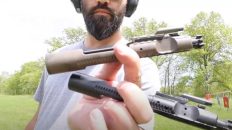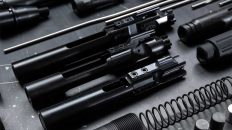If you’ve ever experienced issues with your bolt carrier group gas keys, you know the importance of troubleshooting to keep your firearm functioning smoothly. The gas key is a critical component of the bolt carrier group, responsible for directing the gas from the barrel into the action to cycle the firearm. However, problems can arise, such as loose gas keys, improper alignment, or gas leakage, leading to a decrease in performance or even gun malfunctions.
In this article, we will dive into the most common issues that can arise with bolt carrier group gas keys and provide practical troubleshooting tips to help you resolve them effectively. Whether you’re an experienced firearms enthusiast or a beginner, understanding these troubleshooting techniques can save you time and money. By identifying and overcoming these common problems, you can ensure the longevity and reliability of your firearm.
Stay tuned as we explore the solutions to loose gas keys, misalignment, gas leakage, and other common issues that gun owners may encounter. Don’t let a minor gas key problem disrupt your shooting experience – learn how to troubleshoot and resolve these issues like a pro.
Importance of Gas Keys in Firearm Functioning
Before we dive into the common issues with gas keys, let’s first understand their importance in firearm functioning. The gas key is a small piece that is attached to the bolt carrier group of a firearm. Its primary function is to redirect the high-pressure gas generated by the firing of a round from the barrel into the action of the firearm, allowing the bolt to cycle and chamber the next round. For a detailed overview of what a bolt carrier group is and its crucial role in firearm operation, refer to this guide on what is a Bolt Carrier Group.
The gas key plays a crucial role in the operation of semi-automatic and automatic firearms, as it ensures the smooth and reliable cycling of the firearm. It is designed to withstand high-pressure gas and maintain a secure connection to the bolt carrier group. Any issues with the gas key can result in a decrease in performance, increased recoil, or even complete firearm malfunction.
Now that we understand the significance of gas keys, let’s explore the common issues that can arise and how to troubleshoot them effectively.
One common problem is a loose gas key, which can cause significant malfunctions in your firearm. As Caleb from Brownell explains, “…Whenever you actually fire your firearm gas is going to come from the gas tube into this gas key down into the bolt carrier group and cycle everything. Now, if your gas key is just even the slightest bit loose, gas is going to leak out and it’s going to cause malfunctions and actually a lot of times whenever someone has a loose gas key that’s the last thing they think to check.”
For more insights, you can watch Caleb’s full video on How To Replace an AR-15 Gas Key.
You may ask yourself, how is my gas key loose? Loose screws is one of the common issues with loose gas keys. Over time, the vibrations and recoil generated by firing a firearm can cause the screws securing the gas key to become loose. This can result in a poor connection between the gas key and the bolt carrier group, leading to a decrease in gas transfer and potential malfunctions.
To troubleshoot a loose gas key, start by ensuring the firearm is unloaded and the bolt carrier group is removed. Inspect the gas key screws for any signs of looseness or damage. If the screws are loose, tighten them using an appropriate screwdriver or Allen wrench. Be careful not to overtighten, as this can strip the threads or damage the gas key.
After tightening the screws, ensure the gas key is properly aligned with the bolt carrier group. The gas key should be centered and correctly aligned with the gas tube. If you detect any misalignment, make the necessary adjustments. It’s crucial to torque the gas key screws according to the manufacturer’s specifications. Refer to your firearm’s manual or consult a professional gunsmith for the exact torque values. For further technical details on torque standards, check out the discussion on the M4Carbine.net forum regarding The Two Different Torque Standards on Gas Key Screws.
Regularly inspecting and tightening the gas key screws can prevent potential issues and ensure the proper functioning of your firearm. Remember to perform routine maintenance and checks to ensure the screws remain secure during regular use.
Issue 2: Gas Key Misalignment
Gas key misalignment is another common issue that can occur with bolt carrier group gas keys. When the gas key is not properly aligned with the gas tube, it can lead to gas leakage, decreased gas transfer, and unreliable cycling of the firearm. Proper gas tube alignment is crucial for improved accuracy and reliable cycling, as discussed in this article on Gas Tube Alignment in the AR-15 from American Gunsmith.
To troubleshoot gas key misalignment, start by removing the bolt carrier group from the firearm. Inspect the gas key and gas tube for any signs of misalignment or damage. If misalignment is detected, you may need to make adjustments to ensure proper alignment.
First, loosen the gas key screws and gently align the gas key with the gas tube. It is important to be cautious and not force any movement, as this can cause damage. Once the gas key is properly aligned, tighten the screws to secure it in place. Again, be sure to follow the manufacturer’s torque specifications to avoid any issues.
After making the necessary adjustments, reassemble the firearm and perform a function check to ensure the gas key is aligned correctly and the firearm cycles properly. If the issue persists, it is recommended to seek the assistance of a professional gunsmith for further inspection and troubleshooting.
Issue 3: Gas Key Gas Leakage
Gas leakage from the gas key is another common issue that can affect the performance of your firearm. When the gas key does not create a tight seal with the bolt carrier group, gas can escape, resulting in decreased gas pressure and unreliable cycling.
To troubleshoot gas key gas leakage, start by inspecting the gas key and bolt carrier group for any signs of damage or wear. Pay close attention to the sealing surfaces of the gas key and the bolt carrier group. If any damage or wear is detected, it may be necessary to replace the affected components.
If there are no visible signs of damage, disassemble the bolt carrier group and thoroughly clean the gas key and sealing surfaces. Remove any carbon buildup or debris that may be preventing a proper seal. After cleaning, reassemble the bolt carrier group and perform a function check to ensure the gas key is creating a tight seal.
To prevent gas key gas leakage, it is also recommended to stake the gas key screws. Staking involves deforming the metal around the screws to secure them in place, preventing them from coming loose under the vibration and recoil of firing. This ensures a more reliable seal and reduces the likelihood of gas leakage. For a detailed guide on how to stake your gas key screws, check out The Truth About Guns’ article on Staking Your Gas Key.
In some cases, gas key gas leakage may be caused by a damaged or worn gas key or bolt carrier group. If cleaning and inspection do not resolve the issue, it is recommended to seek the assistance of a professional gunsmith for further evaluation and potential replacement of the affected components.
Issue 4: Gas Key Carbon Buildup
Carbon buildup is a common occurrence in firearms, and the gas key is no exception. Over time, carbon can accumulate on the gas key and its sealing surfaces, leading to decreased gas transfer and potential malfunctions.
To troubleshoot gas key carbon buildup, start by removing the bolt carrier group from the firearm. Inspect the gas key and sealing surfaces for any signs of carbon buildup. If carbon is present, use an appropriate cleaning solvent and a cleaning brush to remove the buildup. Be sure to follow the manufacturer’s instructions for the cleaning solvent and exercise caution to avoid damaging the gas key or sealing surfaces. For a list of effective solvents for removing carbon, check out Armory Den’s Top 7 Solvents for Removing Carbon.
After cleaning, thoroughly dry the gas key and sealing surfaces before reassembling the bolt carrier group. Perform a function check to ensure the gas key is clean and the firearm cycles properly. Regularly cleaning the gas key and sealing surfaces can prevent carbon buildup and ensure the reliable functioning of your firearm.
Troubleshooting Tips for Gas Key Issues
When troubleshooting gas key issues, it is important to follow these general tips to ensure a safe and effective resolution:
- Always ensure the firearm is unloaded before performing any troubleshooting or maintenance.
- Refer to the firearm's manual for specific instructions and torque values.
- Use the appropriate tools and cleaning solvents recommended by the manufacturer.
- Exercise caution when making adjustments or tightening screws to avoid damage.
- If the issue persists or if you are unsure, seek the assistance of a professional gunsmith for further evaluation and troubleshooting.
Preventive Maintenance for Gas Keys
To prevent issues with your gas keys, it is important to perform regular preventive maintenance. Here are some tips to keep your gas keys in optimal condition:
- Inspect the gas key screws regularly and tighten as necessary.
- Clean the gas key and sealing surfaces regularly to prevent carbon buildup. For more detailed maintenance tips, check out The Prepared's AR-15 Maintenance Schedules and Guidelines.
- Check for signs of misalignment or damage during routine maintenance.
- Store your firearm in a clean and dry environment to prevent corrosion or damage to the gas key.
By incorporating these preventive maintenance practices into your firearm care routine, you can ensure the longevity and reliable functioning of your gas keys.
Conclusion
Troubleshooting common issues with bolt carrier group gas keys is essential for firearm owners to maintain the reliability and performance of their firearms. By understanding the importance of gas keys and being able to identify and resolve issues such as loose gas key screws, misalignment, gas leakage, and carbon buildup, you can prevent potential malfunctions and ensure a smooth shooting experience.
Remember to always prioritize safety and follow the manufacturer’s instructions when performing any troubleshooting or maintenance on your firearm. If you are unsure or the issue persists, it is recommended to seek the assistance of a professional gunsmith.
By practicing regular preventive maintenance and addressing gas key issues promptly, you can enjoy the longevity and reliability of your firearm for years to come. Don’t let a minor gas key problem disrupt your shooting experience – learn how to troubleshoot and resolve these issues like a pro.





Add comment